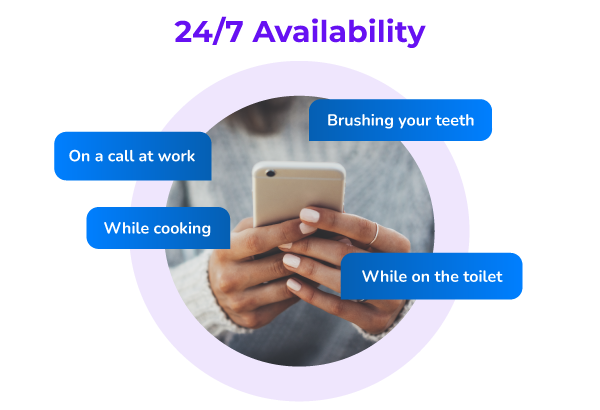
Time is of the essence. For businesses, but even more so for consumers. Consumers don’t like waiting, especially not in customer service. They are hesitant to contact customer service and try to solve it themselves first. The moment they do contact you, they expect effective solutions. FAST.
But how long are customers willing to wait for a response? And what’s more important a fast response, or a human helping them? Our research report delves into the role of speed in customer service, exploring trends and expectations across different generations, regions, and channels.
No surprises here: consumers value quick solutions. Our respondents unanimously agreed (92%) that customer service should respond quickly to questions and problems. Older generations are the most impatient: 97% of the 65+ers agreed, while under the age of 25, this is 88%.
Adding to that high percentage, the nr. 1 annoyance in customer service is “long waiting times”. No matter the age, or origin.
Top 3 annoyances in customer service:
1. Long waiting times
2. Having to repeat yourself
3. Difficulty to reach
So, what do consumers perceive as quick? And when is waiting too long? Consumers demand fast responses on any channel, but their expectations are different.
We asked them within how many minutes they expect a response, for every channel:
The more personal a communication channel is, the faster the response should be. But even on instant messaging channels such as WhatsApp, people don’t mind waiting. They will send the message and continue what they’re doing. If it’s taking too long, people will get annoyed. They might try it via another channel, or their question turns into a complaint.
Expected response times will influence how customers contact you. If it’s urgent, they want an instant response, where face-to-face or phone support is the most suitable. More than 3 in 5 believe they are helped faster when calling, over all other means of communication.
If it’s up to our respondents, customer service is always-on.
More than 60 percent expect 24/7 availability.
For younger generations, this is even more important. Under the age of 35, almost 3 in 4 consumers highly appreciate 24/7 reachability.
Today’s consumer wants to be able to reach you anytime, anywhere. They don’t stop what they’re doing, they contact you while doing the most random things. Did you know customers contact you while on a call at work? Or while cooking? Some even take their moment to reach out while brushing their teeth, or while on the toilet.
A chatbot can help your customer anytime, anywhere.
Fast response times are not the goal. What matters most is an efficient resolution. People don’t mind waiting for a good answer. 7 in 10 consumers prefer a good answer over a direct response. The only thing they want is to get the support they’re longing for. If they easily get their issue resolved, or their question has been answered, they tend to forget the rest. When it was an effortless experience, they won’t start complaining about the channel used, or the length of time they had to wait for.
But it has to be easy and within their line of expectations.
Some say empathy is what differentiates a good service experience from a bad one. Is quality then defined by empathy?
No, not per se.
If you ask consumers whether they want quick support or empathic support, they choose speed over empathy. On average, 54% want to be helped quickly but curtly, rather than empathically with a longer waiting time. Fast support is most important in Germany, China, and the Netherlands. Whereas in France and Belgium, they prefer empathic support. The UK and USA are undecided: 50/50.
Empathy is not the holy grail. Sure, everyone prefers a service experience that has it all: a good solution in a fast, personal, and empathic way. But when consumers have to choose, empathy is the least important. Speed and quality matter most.
But don't be fooled: 88% expect empathy in customer service.
If speed and quality are more important than empathy, are consumers embracing automation? Well, the data tells us they are expecting it.
62% look for customer service that is set up so they can solve it themselves.
Only 1 in 4 consumers are annoyed if only automated customer service is available.
64% expect to be able to reach you any time of the day.
On the other hand, if you let them choose between personal support within office hours or 24/7 help from a chatbot, they prefer personal. They are even willing to wait a day to talk to a human. For younger generations, chatbot acceptance is higher. Under the age of 35, it’s almost 50/50. We didn’t say anything about the solution's effectiveness from the bot or the human agent. If the solution would be the same, we expect the percentages to change.
Looking at the above paragraphs, we can derive five large consumer expectations:
Adding this up, we can conclude an order of importance:
Quality
Personal
Ease
Speed
Empathy
If you think about it, all of the above items are related to valuing your customer. Ensure they get the solution they’re looking for, they feel you understand them, and you are not wasting their time.
Start focusing on your customers. Get to know them. What are their wants and needs? Why and how are they trying to reach you? And what are their expectations?
Start focusing on the right goals. Don’t focus on the first response time, but on resolution time. Don’t focus on satisfaction, but on effort. We like Gartner’s interpretation of “effortless experiences”.
There’s no need to ‘wow’ your customers, just make life as easy as possible for them.
The key to delivering effortless experiences is managing expectations. Tell your audience how they can best reach you, where they can expect the fastest response, and what the waiting times are. Help them find answers themselves. Find the right balance between human support and automation. Automate where possible, and offer human contact where needed.
Want to find out how CM.com can help? Learn more about our customer service solutions or contact us for more information.
Service SolutionsContact usThis research was conducted by CM.com in cooperation with the independent research agency CANDID. The online survey was carried out in October 2022, where 7078 respondents answered questions about their service interactions with businesses. All respondents were aged 18 years or older.
To represent different regions of the world, we surveyed 1000 respondents in each of seven countries, including the United States of America, France, the United Kingdom, Belgium, The Netherlands, Germany, and China.







